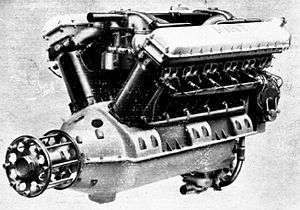Fiat A.20
The Fiat A.20 was an Italian aero-engine of the 1920s. It was a water-cooled V12 engine that was used by early versions of the Fiat CR.20 fighter and the Macchi M.41 seaplane.
| A.20 | |
|---|---|
 | |
| Type | Water-cooled V12 engine |
| National origin | Italy |
| Manufacturer | FIAT |
| Major applications | Fiat CR.20 Macchi M.41 |
In 1923, FIAT built the A.15, a 430 hp (320 kW) water-cooled V12 engine. While no production of the A.15 ensued, it formed the basis for the Fiat A.20, which differed in being a Monobloc engine, and delivered a similar power despite a reduction in capacity from 20.3 to 18.7 L (1,239 to 1,141 in3).[1]
Variants
Applications
- CANT 15
- CANT 25
- Fiat CR.20[3]
- Macchi M.41[4]
- Macchi M.71
- Piaggio P.6
- SIAI S.58bis
- SIAI S.67
- Ansaldo AC.4
Specifications (A.20)
Data from The Fiat A.20 [5], Jane's all the World's Aircraft 1928[2]
General characteristics
- Type: Water-cooled 60° V-12
- Bore: 115 mm (4.53 in)
- Stroke: 150 mm (5.91 in)
- Displacement: 18.7 L (1,141 in3)[6]
- Length: 1,645 mm (64.76 in)
- Width: 645 mm (25.39 in)
- Height: 845 mm (33.27 in)
- Dry weight: 340 kg (749.6 lb)
Components
- Valvetrain: Overhead camshafts operating two inlet and two exhaust valves per cylinder via rockers
- Fuel system: Two twin carburettorss
- Cooling system: water-cooled
Performance
- Power output: **A.20 460 hp (343.0 kW) at 2,300 rpm
- A.20S 510 hp (380.3 kW) at 2,400 rpm
- A.20AQ 430 hp (320.7 kW) at 2,060 rpm maximum continuous; 540 hp (402.7 kW) at 2,400 rpm maximum momentary output
- Compression ratio: **A.20 5.7:1
- A.20S 6:1
- A.20AQ 8:1
- Specific fuel consumption: 0.528 lb/hp/h (0.321 kg/kW/h)
gollark: Why? Lower probability of eventually becoming a full person? The individual parts still have a nonzero one.
gollark: What's the exact threshold for probability you would use?
gollark: Why, though? Why require it for a fetus, which will with some fairly high probability be born and then with some also fairly high (with modern medicine) probability go on to grow up and whatever, but not something with a lower chance of becoming a person?
gollark: Why *humans*, then?
gollark: Can you objectively prove that they have some sort of moral worth, though?
References
| Wikimedia Commons has media related to Fiat A.20. |
- Gunston, Bill (2006). World Encyclopaedia of Aero Engines (5th ed.). Stroud: Sutton Publishing. pp. 72–74. ISBN 978-0-7509-4479-3.
- Grey, C.G., ed. (1928). Jane's all the World's Aircraft 1928. London: Sampson Low, Marston & company, ltd. p. 45d-46d.
- Taylor, Michael J.H. (1981). Warplanes : of the world 1918–1939. London: Ian Allan. p. 54. ISBN 0-7110-1078-1.
- Angelucci, edited by Enzo (1981). World encyclopedia of military aircraft. London: Jane's. p. 124. ISBN 0-7106-0148-4.CS1 maint: extra text: authors list (link)
- Flight 6 May 1926, p.275.
- Flight 9 December 1926, p.807.
External links
- "The Fiat A.20". Flight, 6 May 1926. p. 275.
- "The Fiat Engines". Flight, 9 December 1926, p. 807.
This article is issued from Wikipedia. The text is licensed under Creative Commons - Attribution - Sharealike. Additional terms may apply for the media files.